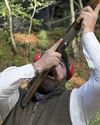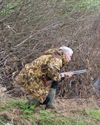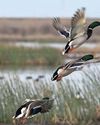
The pheasants have now been in their new home for three weeks, arriving in what was relatively nice dry weather, giving them a good chance to settle into their new habitat. A few days in, we then had what can only be described as biblical rain! Rain that flooded our new home, well, the garages at least. Rain that was almost off the scale! Luckily, the birds had had a few days in their new pen so they could acclimatise. They had already found out where the best places are to shelter and where they could find food and water.
My pens are always built up of a third cover, a third open area and a third of roosting area, which means the birds have somewhere to go and shelter from the weather and then when it dries and brightens up they have an area where they can sun themselves and dust. Always check the forecast for when your pheasants are due; if it is to be wet, it’s best to speak to your game dealer to reschedule. Also, don’t forget to do that final check around the pens just before they arrive – you never know when a tree might have come down on the pen!
After long periods of rain, it can be a high-risk time for your pheasants to pick up disease, such as hexamita, coccidiosis and trichomonas. Always look for the tell-tale signs: birds hunched up, ruffled feathers, very subdued behaviour and diarrhoea. They also rake out their food and play with it rather than eating it. If you see any of these signs, don’t make any assumptions – get your vet to conduct an autopsy and quickly.
Denne historien er fra November 2020-utgaven av Sporting Shooter.
Start din 7-dagers gratis prøveperiode på Magzter GOLD for å få tilgang til tusenvis av utvalgte premiumhistorier og 9000+ magasiner og aviser.
Allerede abonnent ? Logg på
Denne historien er fra November 2020-utgaven av Sporting Shooter.
Start din 7-dagers gratis prøveperiode på Magzter GOLD for å få tilgang til tusenvis av utvalgte premiumhistorier og 9000+ magasiner og aviser.
Allerede abonnent? Logg på

RSPB gives mixed message on shooting
Having recently attended the RSPB’s virtual AGM, Conor O’Gorman discusses the outcome of the charity’s year-long review of game bird shooting

Causeway for concern
Alan Jarrett’s renewed interest in reading takes him down memory lane to an offshore island duck flight that very nearly ended in disaster

Through a purple patch
The Garrows Estate is taking a conservation-focused approach to restoring the wildlife populations and biodiversity on the Scottish heather moorland.

When the wheels fall off
Losing form on a day’s shooting can be infuriating, especially if you’ve been shooting like a god up to that point. Simon O’Leary looks at some common causes and how to remedy them

Beaches, books & bad behaviour!
The annual Kay family vacation to Northumberland offers a chance to give the cockers a blast on the beach – although they don’t always shower themselves in glory, as Ryan Kay recalls...

Using the Stop whistle
Now you’ve instilled the basics, it’s time to up the ante with some more tricky distance work. Howard Kirby explains how to take the core Stop whistle command to the next level

The humble teal
They may be tiny, but as far as Rupert Butler is concerned, the appeal of this little duck is huge. He recalls some of his most memorable nights in pursuit of these aerial acrobats

Fab all-rounder
Mike is impressed with the Fabarm Elos B2 Field Notte, which offers great value for money, is suited to fieldwork or clays and is future-proofed for use with steel in all choke constrictions

CALL OF THE WILD
Dom Holtam reconnects with one of the purest forms of shotgun shooting as he walks-up woodcock over pointing dogs in the Scottish Highlands

A yen for the Fens
Tony Jackson recounts a memorable duck flight over an area of Fenland in Norfolk with his friend and author, the late Alan Savory